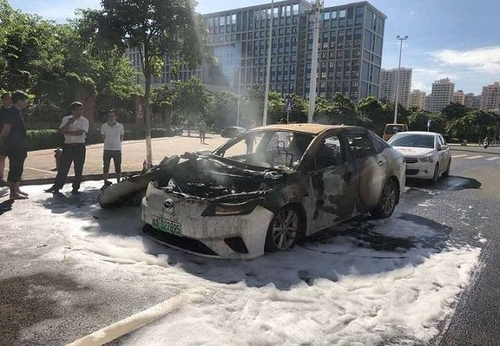EV fires with Chinese batteries expose technology gap
By Kim Byung-wookPublished : Aug. 26, 2020 - 16:50

A series of fires in electric vehicles in China recently has raised concerns over the batteries they are equipped with.
According to local media reports, three Aion S sedans -- Chinese automaker GAC’s first pure EV model -- went up in flames on May 18, Aug. 12 and Aug. 23.
Though GAC hasn’t disclosed an official cause for the cases, the most recent fire reportedly started from batteries manufactured by China’s leading battery maker CATL.
GAC’s Aion S sedans are powered by CATL’s NCM (nickel cobalt manganese) 811 batteries, which contain 80 percent nickel, 10 percent cobalt and 10 percent manganese inside cathodes -- one of the four key components of lithium-ion batteries including anodes, electrodes and separators.
The higher the ratio of nickel inside cathodes, the greater energy density lithium-ion batteries achieve, but less stable they become.
“The yield rate of CATL’s battery factory is reported at 45-55 percent, meaning that almost half of CATL’s batteries are defective,” an industry source said. “There could have been an issue when CATL tried to increase the ratio of nickel.”
In comparison, South Korea’s leading battery maker LG Chem has been supplying NCM811 batteries to Tesla Model 3 sedans and is expected to mass-produce NCMA (nickel cobalt manganese aluminum) batteries that contain 90 percent nickel starting next year.
Samsung SDI said it will apply high-nickel technology to its Gen5 NCA (nickel cobalt aluminum) batteries starting next year to increase the ratio of nickel over 88 percent.
SK Innovation is scheduled to supply NCM batteries that contain 95 percent nickel, 5 percent manganese and 5 percent cobalt to Ford F-150 electric pickup trucks starting 2023.
By Kim Byung-wook (kbw@heraldcorp.com)


















![[Today’s K-pop] Treasure to publish magazine for debut anniversary](http://res.heraldm.com/phpwas/restmb_idxmake.php?idx=642&simg=/content/image/2024/07/26/20240726050551_0.jpg&u=)